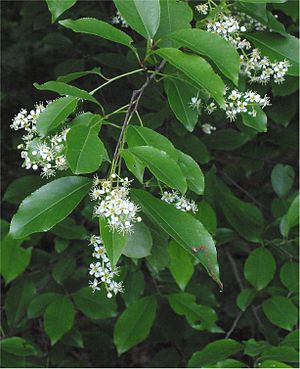Prunus serotina
| Black Cherry | |
|---|---|
 | |
| Binomial: | Prunus serotina |
| Variety: | Rosaceae |
The Black Cherry (Prunus serotina, also occasionally Wild Black Cherry, Rum Cherry, or Mountain Black Cherry) is a large forest tree native to eastern North America from southern Quebec and Ontario south to Texas and central Florida, with disjunct populations in Arizona and New Mexico, and in the mountains of Mexico and Guatemala.[1][2] It is a member in the subgenus Padus.
Description
[edit | edit source]Black Cherry is a deciduous tree growing to 15-30 m tall with a trunk diameter of up to 70-120 cm, occasionally more. The leaves are simple, 6-14 cm long, with a serrated margin. The flowers are in racemes, small (10-15 mm diameter), with five white petals and about 20 stamens, and are fragrant; there are around 40 flowers on each raceme. The fruit is a drupe, 1 cm diameter, green to red at first, ripening black; it is usually astringent and bitter to eat fresh, but sometimes sweet. The fruit is readily eaten by birds, which do not taste astringency as unpleasant.[3][1]
Mature Black Cherry can easily be identified in a forest by its platy, dark grey to black bark, which has the appearance of very thick, burnt potato chips. However, for about the first decade or so of its life, the bark resembles that of a Birch, and is thin and striped. It can also quickly be identified by its long, shiny leaves resembling that of a Sourwood, and by an almond-like odor when a young twig is scratched and held close to the nose.
Black Cherry is closely related to the Chokecherry (Prunus virginiana), from which it differs in the larger leaves and the cherries, which are black when ripe (hence the name), not red, though some populations of Chokecherry also produce black fruit.
Growing Conditions
[edit | edit source]The Black Cherry is a pioneer species. In the Midwest, it is seen growing mostly in old fields with other sunlight loving species, such as Black Walnut, Black locust, and Hackberry. It is a moderately long-lived tree, with ages of up to 258 years known, though it is prone to storm damage with branches breaking easily; any decay resulting however only progresses slowly[1]
Varieties
[edit | edit source]There are two subspecies:[4]
- Prunus serotina subsp. serotina. Canada, United States.
- Prunus serotina subsp. capuli (Cav.) McVaugh. Mexico, Guatemala.
The typical subsp. serotina is sometimes further divided into four varieties, var. serotina in the east of the range, var. eximia in Texas, and vars. rufula and virens in Arizona, New Mexico and Texas.[2]
Uses
[edit | edit source]
The fruit is suitable for making jam and cherry pies; they are also a popular flavoring for sodas and used in many ice creams.
The timber is valuable, perhaps the premier cabinetry timber of the U.S., traded as "cherry". It is known for its strong red color and high price.
Maintenance
[edit | edit source]The foliage, particularly when wilted, contains cyanogenic glycosides which convert to hydrogen cyanide if eaten by animals.[3] It is recommended that farmers remove any Black Cherry trees that fall in a field containing livestock, because the wilted leaves could poison the animals. Removal is not always practical though, because Black Cherries often grow in very large numbers on farms, taking advantage of the light brought about by mowing and grazing. Entire fencerows can be lined with this poisonous tree, making it difficult to monitor all the branches falling into the grazing area.
Black Cherry is locally naturalized in parts of Europe, having escaped from cultivation as an ornamental tree.[5]
Propagation
[edit | edit source]Generally propagated by seed.
Harvest
[edit | edit source]Wood is harvested when trees are mature (at least 24" diameter). Cherries can be difficult to harvest because of the height of the tree.
Pests and Diseases
[edit | edit source]See List of Lepidoptera which feed on Prunus. The Eastern tent caterpillar defoliates entire groves some springs.
References
[edit | edit source]- ↑ a b c Marquis, D. A. (undated). U.S. Forest Service Silvics Manual: Prunus serotina Ehrh. - Black Cherry
- ↑ a b USDA Plants Profile: NCRS: Prunus serotina
- ↑ a b Missouriplants: Prunus serotina
- ↑ Germplasm Resources Information Network: Prunus serotina
- ↑ Flora of NW Europe: Prunus serotina
| Wikiversity is collecting bloom time data for Prunus serotina on the Bloom Clock |
- Book:Horticulture/Finder/Types/Trees, Large
- Book:Horticulture/Finder/Seasons/Spring
- Book:Horticulture/Finder/Conditions/Part Shade
- Book:Horticulture/Finder/Conditions/Full Sun
- Book:Horticulture/Finder/Conditions/Drought Tolerant
- Book:Horticulture/Finder/Types/Fruits and Vegetables
- Book:Horticulture/Finder/Native/North America
- Book:Horticulture/Finder/Flowers/White
- Book:Horticulture/Finder/Toxicity/Livestock or Pets
